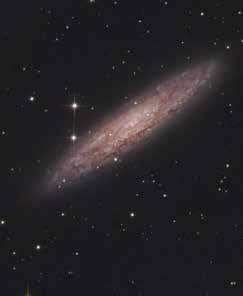
3 minute read
The Skies Above Bribie
October 2021
Silver Coin Galaxy by Katherine Miller.
Advertisement
The Skies Above Bribie

By: John Stevenson
Triangulum Galaxy
Spring is such a welcome part of the year for me. I feel the cold of our Bribie winters and always look forward to the warmer spring/summer weather, even though my 9-year-old, much-loved cocker spaniel, Carlton, struggles with the daytime heat. He often accompanies me observing the night sky in spring and summer, looking inquisitively at me and what I'm doing, before eventually falling asleep on the grass.
Definitely no shortage of planets in the October sky. Venus, bright and conspicuous in the western sky just after sunset, Jupiter and Saturn high overhead. Uranus and Neptune are also there for the adventurous. Last month’s spectacular photo of Saturn by Mr. Dylan O’Donnell of Byron Bay Observatory, attracted a lot of attention from our readers, so this month features his recent photo of Jupiter, with its Great Red Spot. The Great Red Spot, is a gigantic storm, approximately twice the size of earth, and has been raging for centuries. Scientists predict however it will only last another 20 years before it disappears forever. Jupiter in a small telescope or binoculars will show 4 of its brightest moons. A modest telescope is needed to see cloud bands and moon shadows cast onto the planet. It's a magnificent object to study each night. The first week of October will be the only time to see comet 342P/SOHO as it moves closer to the sun in its 5.5year orbit. It might be visible between Venus and the horizon in the evenings using binoculars. Comets are highly unpredictable with brightness, so possibly a small telescope may be needed. It's been a long time since a reasonably bright comet has been visible from Bribie, so this might be worth a look, but the opportunity will be short.
Throughout October, the Milky Way is getting lower in the west. The Southern Cross and Pointers are getting to their lowest point in our sky. In the east, however, as the earth faces away from the centre of our galaxy and opens up this wonderful window, looking out to the rest of our universe.
As I mentioned last month, Andromeda Galaxy is visible from mid-October, about 9.30 pm, but quite low to the north eastern horizon. Andromeda Galaxy is said to contain one trillion stars, twice as many as our own galaxy. In binoculars, it's quite an amazing sight. Another galaxy, along with the large and small Magellanic clouds, within our local group, and visible with binoculars in October, is the Triangulum Galaxy. This galaxy is 3 Million lightyears away, and as can be seen in my photo, is a beautiful object, even using a small telescope. Katherine Miller's photo of the Silver Coin Galaxy is far more distant and in the next group of galaxies, 12 Million light-years away, part of the Sculptor group.
The soon to be replaced Hubble Space Telescope could see galaxies of a distance of 13 Billion Light years. Its replacement, to be launched in December,
The James Webb Telescope, is 100 times more powerful and will give mankind views of the past never before seen, and may explain the origins of our universe. Our skies are a fascinating part of our environment. The more you explore, the more you will want to learn.

Jupiter by Dylan O'Donnell
Stay safe beautiful Bribie.
Always ready to answer questions by email bribie.astronomer@gmail.com John Stevenson Owner/Operator of Banksia Observatory









